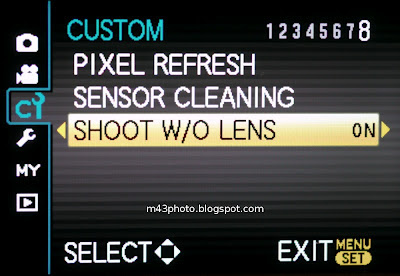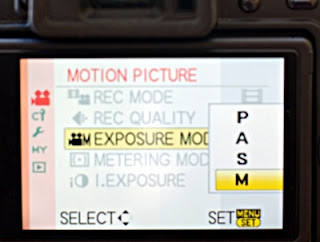I have already written a
review of the Lumix G 12.5mm f/12 3D lens. In the review, I concluded that you should not buy the lens. One of the reasons was the lack of the possibility to record 3D videos, which is a strange omission.
However, it is of course possible to fool the camera into believing that the 3D lens is
not attached, in which case video recording becomes a possibility. The way to do this, is to put some plastic tape over the electrical contacts of the lens. Then, the camera will not be able to communicate with the lens, and fails to notice its 3D properties, treating it like any other lens.
For this to work, you must enable the "shoot without lens" option on the camera:
Here is a video illustrating how to do this:
Be careful, though. If pieces of the plastic tape comes off and falls into the sensor, that can cause big problems.
Video
Using this method on the GH1 camera, I was able to use much more of the sensor than what is being used when taking 3D still images. As illustrated by the image below, I cropped off the centre 120 pixel column, and used the rest to make an anaglyph 3D video:
This uses a total of 94% of the sensor area.
As I wrote in the review, when the 3D lens is used in the conventional way, only 35% of the sensor area is used. Used this way, there is an additional crop ratio of 2.4, meaning that the lens becomes a short tele lens of 30mm, just like the
Sigma 30mm f/2.8 EX DN.
The way I use the lens as a video lens, though, the crop ratio is only 1.6, giving a focal length equivalent of 20mm, a slightly short normal lens. So the field of view of the 3D lens becomes more useful with the plastic tape trick.
On the other hand, the resolution of 900x1080 pixels is quite unusual, and it is likely that you need to crop this to actually use it in any sensible way.
Here is an example video. The video is anaglyph, and must be watched with red/cyan glasses.
There is still some vignetting in the corners, but this proves that it is possible to record 3D videos with the
Lumix G 12.5mm f/12 3D lens.
Still images
You can use this trick with still images as well. It gives you a larger image to work with, rather than the 1920x1440 3D image pair you normally get. Here is an example image taken when using the plastic tape trick. The areas used by the 3D lens in the conventional way are highlighted with the rectangles:
Using the lens in the conventional way yields this image:
When using the whole sensor frame output, though, you can get a much larger field of view, using 1930x3016 pixels per 3D image:
This shows that when fooling the camera into not knowing that the 3D lens is connected, you can get a larger sensor area to work with. The disadvantage is that you need to compile it into 3D manually, and also, you are stuck with the portrait format, unless you crop it down to landscape format, though. You could also use the RAW file, this way.
Alternative lens
Loreo also produces a 3D lens for Micro Four Thirds. It uses the same principle: Two lenses project an image on the left and right part of the sensor, and they must be combined into a 3D video. Unlike the Lumix 12.5mm 3D lens, though, the Loreo lens has a more sensible distance between the lenses, the stereo base, giving a more pronounced 3D effect:
The Loreo lens uses the same principle as the
Lumix G 12.5mm f/12 3D lens. It projects two images side by side on the sensor. The big difference, though, is that the Loreo lens has a much larger stereo base, and uses mirrors to project the images into the relatively small sensor. The Lumix 3D lens, on the other hand, does not use mirrors at all, and places both lenses inside the sensor area.
So you end up with the same problems when using the Loreo lens as well: You are restricted to the portrait format, both when using still images and video. Of course, you can crop the images down to a horizontal landscape format, but then you lose quite a bit of resolution when cropping.

















